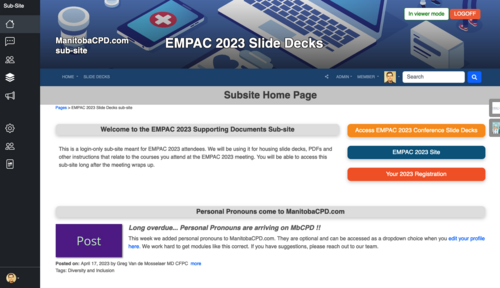
The concept of sub-sites involves the practice of running an unlimited number of real websites inside a larger website to save on cost and confusion. This is not a new idea. Getting it right can be a challenge. It draws on all that you know about website design.
In this case PrimaryON.ca's sub-site module this is a form-follows-function project born out of a request from a sub-unit when I was CTO at a CHI (Center for Healthcare Innovation) in Western Canada. Sub-sites seek to address a situation that other communications people, web designers and programmers will be only too familiar with. An influential group inside my CHI came to the CEO saying that although they liked being on the CHI's website, they didn't feel it thoroughly explained who they were as a sub-unit. (Translation they didn't like the site ... it happens) They felt to remedy the situation they ALSO needed their own specific branded website as a place to tell their story that was outside of our CHI's website. The ask was for our CHI to build a completely separate WordPress site for them. They promised they would keep both up to date.
Wearing both a Comm's and Programmer's hat, I recognized this as a clear violation of the DRY principle. The extra work this would impose on the CHI and the breakaway unit would mathematically guarantee that both sites would not benefit. The best we could hope for is that at least the breakaway unit would thrive. However, I had to try to balance both interests. The group was correct. Being seen as a part of a bigger website is a sign of weakness and it does effect your branding. This does translate to an opportunity costs. At the same time, we, as the administration, had the right to push back. This was an extra cost and a hit to the CHI’s brand. If done poorly it would add points of fragility and ever expanding work to keep the two sites in sync.
What resulted from this balancing was the concept of running a site inside a site. The back-end server would be the same. All user information would be pulled from the core so that sub-sites could be created and taken down with minimum effort. This freed up the members of the sub-unit to use their imagination as it related to the content. They were free of the complexity of having to run their website. We could contain costs and avoid complex dependencies.
When I came out to Ontario, the CHI's funding, like many other CHIs, ended. It's own site was gobbled up by the University. There is always a bigger fish. We continued to work on the module though. I moved this module to PrimaryON.ca initially in 2020 and worked on it pro-bono on it through the pandemic. It had recently gotten new shine under another client as their sub-sites module. That client shifted their focus in the summer of 2023 but EM2data.com has carried on the development work pro-bono as of the late spring and summer of 2023 to further it's development (it's a good idea)
The benefits are real..
The cost to the OMA to spin up a sub-site for a group of health care providers => none
The cost in lost productivity if a sub-site turns out to be not what was needed => none
All costs are already occuring as a result of serving up PrimaryON.ca .. this adds little to the added costs.
You can find this module at PrimaryON.ca/sub-sites
Update (November 2023) ..
The ability to automatically export to external websites has arrived. You can also see the output here .. https://www.primarycarenetwork-mh.ca/ which draws its content from https://www.PrimaryON.ca/sub-sites/5-mh-pcn .
We can now bundle your work to external websites to further help with your brand needs.
Posted:
March 21, 2024 by Greg Van de Mosselaer
Regions: Canada